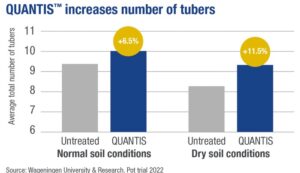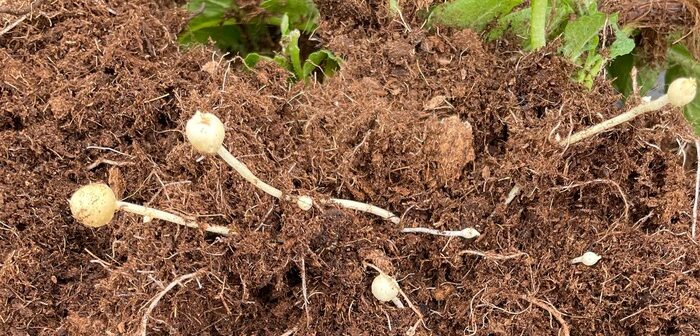New research reveals applying Quantis at tuber set timing enables potato plants to produce and support more tubers. Furthermore, the weight of individual tubers was increased, to boost overall output through the crucial growth stage.
The beneficial increase in tuber numbers with the early tuber set Quantis timing was also seen even where no stress events occurred, according to Syngenta Technical Manager, Andy Cunningham.
The Syngenta Potato Science trials, in collaboration with Wageningen University & Research in Holland and using the commercial variety Innovator, revealed the optimum timing was when most of the setting tubers were at the small pea size.
Under stressful dry conditions treated plants successfully created over 11% more tubers from a single Quantis application, compared to untreated – equating to around 45,000 extra tubers per hectare at field plantings. Plants growing under normal stress-free conditions also produced and supported a 6.5% increase in tuber numbers with the Quantis tuber initiation treatment.
8% increase in tuber weight
The size of each tuber on plants growing under dry stress conditions still averaged more than the untreated crop, along with an 8% increase in average tuber weight for the greater number of tubers from plants under normal conditions.
Researchers at Wageningen University also assessed the stolon numbers of plants, showing a 30% increase in the Quantis treated crop under both dry stress and normal growing conditions. Increasing stolon numbers is an important element of an integrated rhizoctonia management strategy, suggested Mr Cunningham.
 Tuber set and the onset of tuber growth is a period when potato plants are highly susceptible to stress factors, such as heat. “There is a huge wealth of scientific research, replicated trials and field experience that inarguably show Quantis can reduce the effects on growing plants during periods of heat stress, and deliver a significant yield increase,” he reported.
Tuber set and the onset of tuber growth is a period when potato plants are highly susceptible to stress factors, such as heat. “There is a huge wealth of scientific research, replicated trials and field experience that inarguably show Quantis can reduce the effects on growing plants during periods of heat stress, and deliver a significant yield increase,” he reported.
“Now, the new research reveals that with an initial application at the tuber set stage to encourage plants to produce more and larger tubers, there is the potential to keep them growing more efficiently and make better use of resources right through the season.”
Mr Cunningham advocates Quantis should be applied as a standard treatment with a blight spray at the start of tuber set, at a rate of 2.0 l/ha. “The strategy can add tuber numbers and size to all crops. It could prove especially useful for seed production to increase number yield.”




